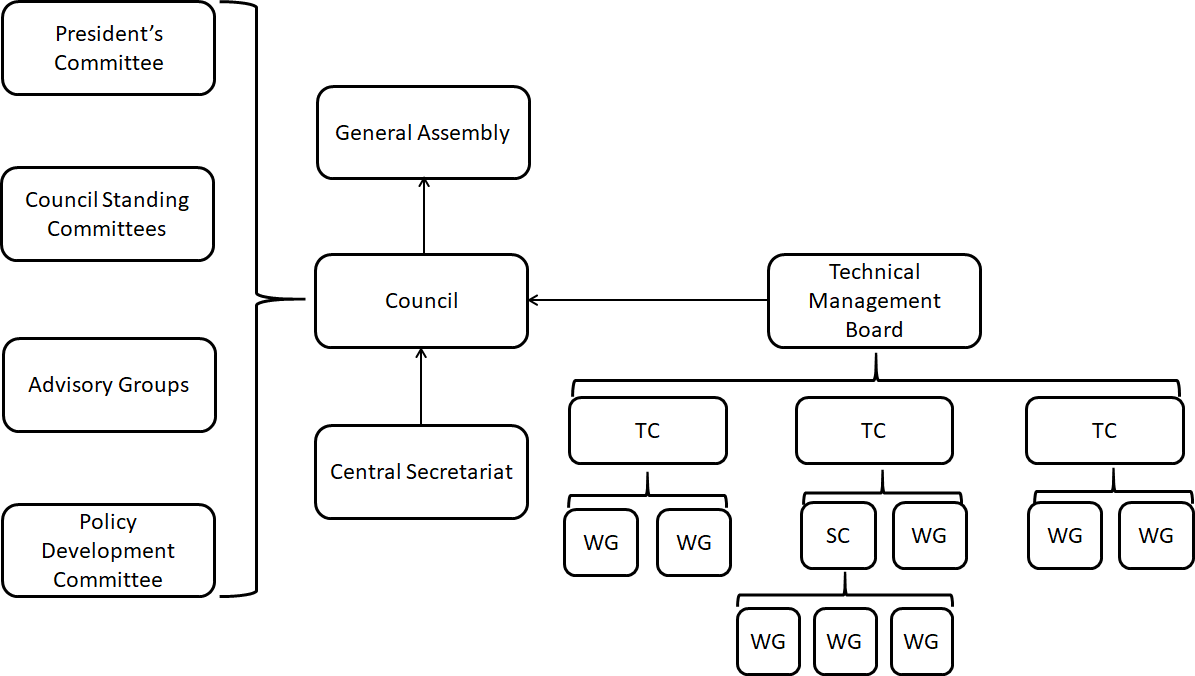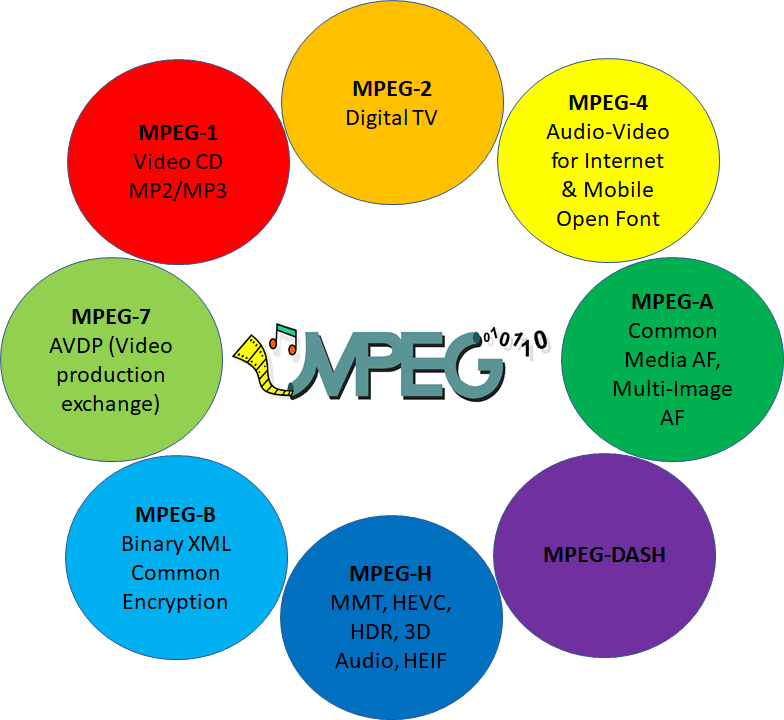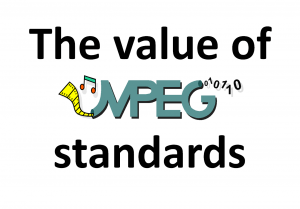Introduction
The article MPEG: what it did, is doing, will do recounts my statistically not insignificant experience of asking taxi drivers across different cities of the world if they know MPEG. I do not have similar amount of data to report for ISO, but I am pretty sure that if I asked a taxi driver if they know ISO, the yes rate would be considerably lower than for MPEG.
This is not merit of MPEG or demerit of ISO as organisations. MPEG – Moving Pictures Experts Group – is lucky to deal with things that let people make content that other people can see and hear in ever new ways. ISO – International Organisation for Standardisation – is an organisation with the mission to develop international standards for anything that is not telecommunication – the purview of the International Telecommunication Union (ITU) – and electrotechnical – the purview of the International Electrotechnical Commission (IEC).
The ISO organisation
The above may seem rather abstract, so let’s see what the difference means in practice. ISO is a huge organisation structured in Technical Committees (TC). Actually, the structure is more complex than that (see Figure 1), but for the purpose of what I want to say, this is enough.
The first 3 – still active – TCs in ISO are: TC 1 Screw threads, TC 2 Fasteners and TC 4 Rolling bearings. The standards produced by these TCs are industrially very important, but the topics hardly make peoples’ hearts beat faster. The last 3 TCs in order of establishment are TC 322 Sustainable finance, TC 323 Circular economy and TC 324 Sharing economy. The standards produced by these TCs are important for the financial industries, but probably little known even in financial circles. Between these two extremes we have a large number of TCs, e.g., TC 35 Paints and varnishes, TC 186 Cutlery and table and decorative metal hollow-ware, TC 249 Traditional Chinese medicine, TC 282 Water reuse, TC 297 Waste collection and transportation management, etc.
ISO TCs work on areas of human endeavour that are extremely important to industrial and social life. Many of these activities, however, do not say much to man in the street.
Where is MPEG in this picture? To answer this question I need to dig deeper in the ISO organisation. Most TCs do not have a monolithic structure. They are organised in working groups (WG). TCs retain key functions such as strategy and management, and WGs are tasked to develop standards. In quite a few cases the area of responsibility is so broad that a horizontal organisation would not be functional. In this case a TC may decide to establish Subcommittees (SC). They are like mini TCs where WGs developstandards under them.`

Figure 1 – ISO governance structure
In 1987 ISO/TC 97 Data Processing merged with IEC/TC 83 Information technology equipment. The resulting (joint) technical committee was and is called ISO/IEC JTC 1 Information Technology. One JTC 1 SC, SC 2 Character sets and Information Coding of JTC 1, included WG 8 Coding of Audio and Picture Information. WG 8 established the Moving Picture Experts Group (MPEG) in January 1988. In 1991 when SC 2/WG 8 seceded from SC 2 and became SC 29, MPEG became WG 11 Coding of audio, picture, multimedia and hypermedia information (but everybody calls it MPEG).
MPEG changed the world of media
Those who have survived the description of the ISO organigram will now have the opportunity to understand how this group of experts, in the depths of the ISO (and IEC) organisation changed the world of media and impacted the lives of billions of people, probably all of those on the face of the Earth, if we exclude some hermits in the few surviving tropical forests, the many deserts or the frozen lands.
The main reason of the success of MPEG is that for 30 years it had carte blanche to implement its ideas. Some of them were clear at the outset, others took shape from a process of learning on the job.
Let’s revisit MPEG’s ideas of standardisation to understand what it did and why.
Idea #1 – Single standards for all countries and industries
The first idea relates to the scope of MPEG standards. In the analogue world absence or scarce availability of broadband communication or deliberate policies or the natural separation between industries that traditionally had little in common, favoured the definition of country-based or industry-based standards. The first steps toward digital video undertaken by countries and industries trod similar paths: different countries and industries tried their own way independently.
MPEG jumped in the scene at a time the different trials had not had the time to solidify, and the epochal analogue-to-digital transition gave MPEG a unique opportunity to effect its disruptive action.
MPEG knew that it was technically possible to develop generic standards that could be used in all countries of the world and in all industries that needed compressed digital media. MPEG saw that all actors affected – manufacturers, service providers and end users – would gain if such a bold action was taken. When MPEG began to tread its adventurous path, MPEG did not know whether it was procedurally possible to achieve that goal. But it gambled and gave it a try. It used the Requirements subgroup to develop generic requirements, acted on the major countries and trade/standards associations of the main industries and magically got their agreement.
The network of liaisons and, sometimes, joint activities is the asset that allowed MPEG to implement idea #1 and helped achieve many of the subsequent goals.
Idea #2 – Standards for the market, not the other way around
Standards are ethereal entities, but their impact is very concrete. This was true and well understood in the world of analogue media. At that time a company that had developed a successful product would try to get a “standard” stamp on it, share the technology with its competitors and enjoy the economic benefits of their “standard” technology.
With its second idea MPEG reshuffled the existing order of steps. Instead of waiting for the market to decide which technology would win – an outcome that very often had little to do with the value of the technology – MPEG offered its standard development process where the collaboratively defined “best” is developed and assessed by MPEG experts who decide which individual technology wins. Then the “standard” technology package developed by MPEG is taken over by the market.
MPEG standards are consistently the best standards at a given time. Those who have technologies selected to be part of MPEG standards reap the benefits and most likely will continue investing in new technologies for future standards.
Idea #3 – Standards anticipate the future
The third idea is a consequence of the first two. MPEG-1 was driven by the expected possibilities of the audio and video compression technologies of the time. It was a bet on silicon making it possible to execute the complex operations implied by the standard so that industry could build products of which there was no evidence but only educated guesses: interactive video on CD and digital audio broadcasting. Ironically, neither really took off, but other products that relied on the MPEG-1 technologies – Video CD and MP3 – were (the former) and still are (the latter) extremely successful.
MPEG standards anticipate market needs. They are regularly bets that a certain standard technology will be adopted. In More standards – more successes – more failures you can see how some MPEG standards are extremely successful and other less so.
Idea #4 – Industry-friendly standards
The fourth idea was simple and disruptive. Since its first instances in the 1920s, industry and governments have created tens of television formats, mostly around the basic NTSC, PAL and SECAM families. Even in the late 1960’s, when the Picturephone was developed, AT&T invented a new 267-line format, with no obvious connection with any of the existing video formats.
MPEG never wanted to define its own format. With its fourth idea, propped up by the nature of digital technologies, it just decided that it would support any format. Here is how it did it:
- One standard with not options (this should be obvious, because it is what a standard should be about)
- Standards apply only to decoders; encoders are implicitly defined and have ample margins of implementation freedom
- Profiles (hierarchical, if possible) to accommodate special industry needs within the same standard
- Decoders are defined by their ability to process data, quantised in levels (based on bitrate, resolution etc.)
- How different formats are handled is outside of MPEG standards.
Idea #5 – Audio and video come together
The fifth idea was kind of obvious but no less disruptive. Because of the way audio and video industries had developed – audio for a century and video for half a century – people working on the corresponding technologies tended to operate in “watertight compartments”, be they in academia, research or companies. That attitude had some justification in the analogue world because the relevant technologies were indeed different and there was not so much added value in keeping the technologies together, considering the big effort needed to keep the experts together.
However, the digital world with its commonality of technologies, no longer justified keeping the two domains separate. That is why MPEG, just 6 months after its first meeting, kicked off the Audio subgroup after successfully assembling in a few months the best experts.
This injection of new technology with the experts that carried it was not effortless. When transformed into digital, audio and video signals are bits and bits and bits, but the sources are different and influence how they are compressed. Audio experts shared some (at a high level) compression technologies – Subband and Discrete Cosine Transform – but video is (was) a 2D signal changing in time often with “objects” in it, while audio is (was) a 1D signal. More importantly, audio experts were driven by other concerns such as the way the human hearing process handles the data coming out of the frequency analysis carried out by the human cochlea.
The audio work was never “dependent” on the video work. MPEG audio standards can have a stand-alone use (i.e. they do not assume that there is a video associated with it), but there is no MPEG video standard that is without an MPEG Audio standard. So it was necessary to keep the two together and it is even more important to do so now when both video and audio are both 3D signals changing in time.
Idea #6 – Don’t forget the glue that keeps audio and video together
The sixth idea can be described by the formula
Audio and Video ≠ (Audio + Video)
This may look cryptic but it states the obvious. Having audio and video together does not necessarily mean that audio and video will play together in the right way if they are stored on a disk or transmitted over a channel.
The fact that MPEG established a Digital Storage Media subgroup and a Systems subgroups 18 months after its foundation signals that MPEG has always been keenly aware of the issue that a bitstream composed by MPEG audio and video bitstreams need to be transported to be played back as intended by the bitstream creator. In MPEG-1 it was a bitstream in a controlled environment, in MPEG-2 it was a bitstream in a noisy environment, from MPEG-4 on it was on IP, in MPEG-DASH it had to deal with unpredictability of the Internet Protocol in the real world.
During its existence the issue of multiplexing and transport formats have shaped MPEG standards. Without a Systems subgroup, efficiently compressed audio and video bitstreams would have remained floating in the space without a standard means to plug them into real systems.
Idea #7 – Integrated standards as toolkits
Most MPEG standards are composed of the 3 key elements – audio, video and systems – that make an audio-visual system and some, such as MPEG-4 and MPEG-I, even include 3D Graphic information. These standards are integrated in the sense that, if you need a complete solution, you can get what you need from the package offered by MPEG.
The world is more complicated than that. Some users want to cherry pick technologies. In the case of MPEG-I, most likely MPEG will not standardise a Scene Description technology but will just indicate how externally defined technologies can be plugged into the syste.
With its seventh idea MPEG is ready to satisfy the needs of all customers. It defines the means to signal how an external technology can be plugged into a set of other native MPEG technologies. With one caveat: customer has to take care of the integration of the external technology. That MPEG will not do.
Idea #8 – Technology is always on the move
To describe the eight idea, I will seek help from the Greek philosopher Heraclitus (or whoever was the person who said it): τὰ πάντα ῥεῖ καὶ οὐδὲν μένει (everything flows and nothing stays). Digital technologies move fast and actually accelerate. By applying idea #3, #4, #5, #6 and #7, MPEG standards accelerated the orderly transition of analogue to digital media. By applying ideas #1 and #2, MPEG standards prompted technology convergence with its merging of industry segments and appearance of new players.
The seventh idea reminds MPEG that the technology landscape is constantly changing and this awareness must inform its standards. Until HEVC – one can even say, including the upcoming Versatile Video Coding (VVC) – video meant coding a 2D rectangular area (in MPEG-4, a flat area of any shape). The birth of immersive visual experiences is not without pain, but they are becoming possible and MPEG must be ready with solutions that take this basic assumption into account. This means that, in the technology scenario that is shaping up, the MPEG role of “anticipatory standards” is ever more important and ever more challenging to achieve.
Idea #9 – The nature and borders of compression
The ninth idea goes down to the very nature of compression. What is the meaning of compression? Is it “less bits is always good” or can it also be “as few meaningful bits as possible is also good”? The former is certainly desirable but, as the nature of information consumption changes and compression digs deeper in the nature of information, compressed representations that offer easier access to the information embedded in the data becomes more valuable.
What is the scope of application of MPEG compression? When MPEG started the MPEG-1 standards work, the gap that separated the telecom from the CE industries (the first two industries in attendance at that time) were as wide as the media industry and, say, the genomic industries today. Both are digital now and the dialogue gets easier.
With patience and determination MPEG has succeeded in creating a common language and mind set in the media industries. This is an important foundation of MPEG standards, The same amalgamation will continue between MPEG and other industries.
Now the results
Figure 2 intends to attach some concreteness to the nine ideas illustrated above by showing some of the most successful MPEG standards issued from 31 years of MPEG activity.

Figure #2 – Some successful MPEG standards
Conclusion
An entity at the lowest layer of the ISO hierarchy has masterminded the transition of media from the analogue to the digital world. Its standards underpin the evolution of digital media, foster the creation of new industries and offer unrelenting growth to old and new industries worth in excess of 1 trillion USD per year.
Many thanks to the parent body SC 29 for managing the balloting of MPEG standards.
Posts in this thread
- MPEG and ISO
- Data compression in MPEG
- More video with more features
- Matching technology supply with demand
- What would MPEG be without Systems?
- MPEG: what it did, is doing, will do
- The MPEG drive to immersive visual experiences
- There is more to say about MPEG standards
- Moving intelligence around
- More standards – more successes – more failures
- Thirty years of audio coding and counting
- Is there a logic in MPEG standards?
- Forty years of video coding and counting
- The MPEG ecosystem
- Why is MPEG successful?
- MPEG can also be green
- The life of an MPEG standard
- Genome is digital, and can be compressed
- Compression standards and quality go hand in hand
- Digging deeper in the MPEG work
- MPEG communicates
- How does MPEG actually work?
- Life inside MPEG
- Data Compression Technologies – A FAQ
- It worked twice and will work again
- Compression standards for the data industries
- 30 years of MPEG, and counting?
- The MPEG machine is ready to start (again)
- IP counting or revenue counting?
- Business model based ISO/IEC standards
- Can MPEG overcome its Video “crisis”?
- A crisis, the causes and a solution
- Compression – the technology for the digital age
- On my Charles F. Jenkins Lifetime Achievement Award
- Standards for the present and the future


